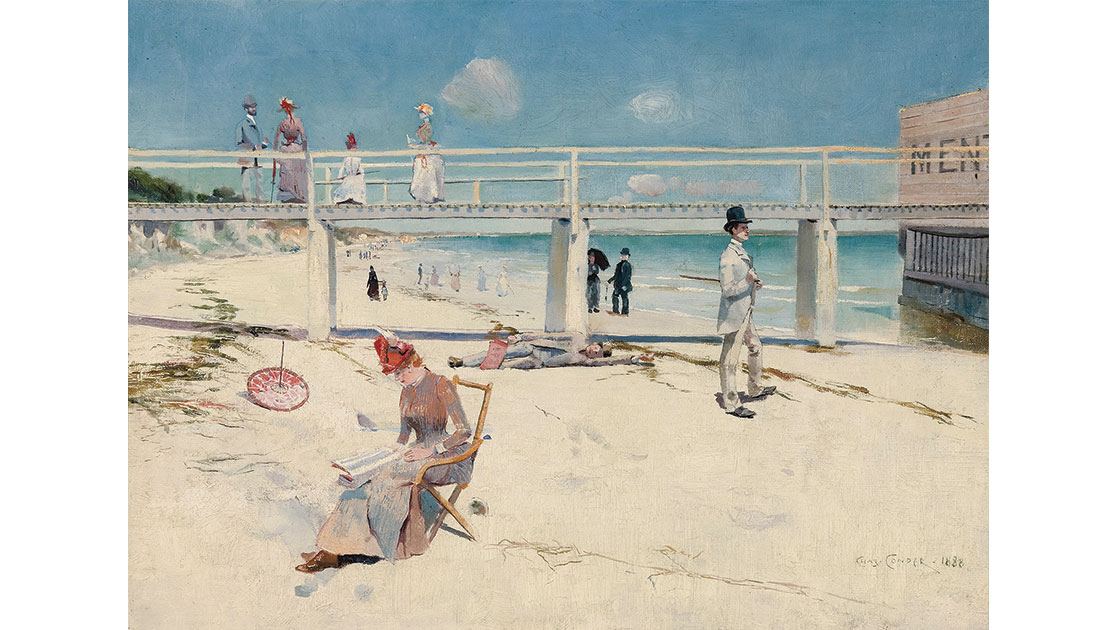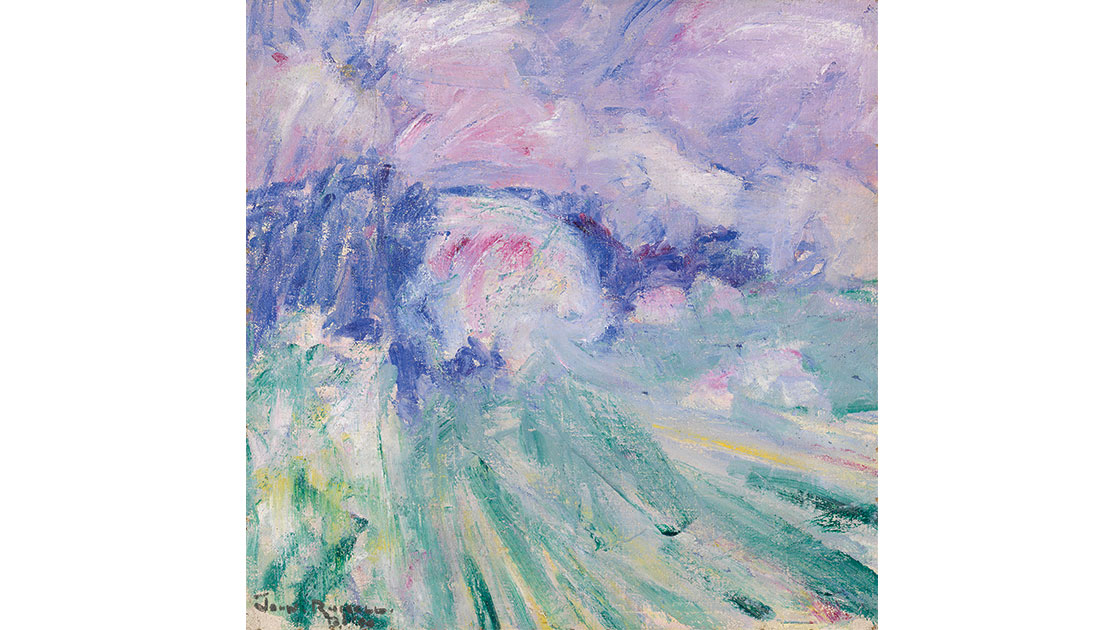Australia’s Impressionists
Recently, Impressionism has been the subject of key exhibitions in Australia and overseas. There's the ongoing 'Australian Impressionism' show at the National Gallery of Australia (NGA); 'Colours of Impressionism' at Art Gallery of South Australia (AGSA), and the 'Australian Impressionism' exhibition at the National Gallery of Victoria – all in 2018.
In Issue 38, Stella Downer reviews 'Shock of the Blue: Australia's Impressionists' staged at the National Gallery of London in 2017, looking at the paintings of four key artists: Arthur Streeton, Tom Roberts, Charles Conder and John Peter Russell.
Each time I visit London, one of my first calls is to Trafalgar Square and The National Gallery. This must be my favourite gallery anywhere – the temple of my soul! Walking through the galleries filled with the centuries of paintings that I would acknowledge with a nod, talk to with admiration and at times with love, I came to a smaller gallery in the centre of the building, the Sunley Room. Here is the Australia’s Impressionists exhibition.
These much-loved paintings at home, icons of Australian art, seem to have shrunk in the presence of their forebears. They seemed light years away from the 400 years of painting that I had walked past. And “light” is the operative word.
Tom Roberts’ ‘Trafalgar Square’ (c. 1884), strategically placed opposite the entrance, greeted me. Here was the Trafalgar Square that I had walked through on that wintry early January day. This small work on cardboard, heavily influenced by Whistler, is seen in the monotones of greys and blacks against a pearly bright sky. There is a touch of Australian brightness in that sky, albeit a winter’s sky.
Opposite is an installation of 9 x 5 inch wooden cigar box panels. We in Australia are used to seeing these and their history is well known, having been exhibited in Melbourne in 1889. Here in the very small selection of the original 183 “impressions” I am reminded that the impact of this 9 by 5 Impression Exhibition has been lasting and it is regarded as one of the most significant Australian exhibitions ever to be mounted. Research has been respected and this group has been hung as per the original 1889 exhibition.
Australian art so often relates to the land, and Australian nationalism was hitting its stride around the centenary of European settlement in 1888. With this came a growing sense of national identity. En plein air painting was embraced first by Tom Roberts while travelling in Europe in the early 1880s. This provided the basis of a new school of painting.
It can be argued that the magnificent ‘Golden Summer, Eaglemont’ painted by Arthur Streeton in 1889 is the epitome of en plein air painting of the late 1880s. If any painting could be called “iconic” of Australian Impressionism, it could be this. Painted during a summer drought when Streeton was only 21 years old, it breathes the hot, dry grass and intense blue sky that is a southern Australian summer. Here is the high-keyed blue and gold palette that the artist considered “nature’s scheme of colour in Australia”. It is exciting to see this painting back in London. It was exhibited at the Royal Academy London in 1890 and at the Paris Salon the following year where it won an award.
Close by is Arthur Streeton’s ‘Still glides the stream and shall for ever glide’ (1890), painted at Eaglemont near Heidelberg. More romantic than ‘Golden Summer’, it befits the title, which was taken from Wordsworth’s sonnet ‘After-Thought’ from his poem cycle ‘The River Duddon’.
A magnificent wall is a triumvirate of paintings: Charles Conder’s ‘A Holiday at Mentone’ (1888), Arthur Streeton’s ‘Fire’s on’ (1891), and Tom Roberts’ ‘A break away!’ (1891). What a treat to see these three outstanding paintings hanging together. ‘Mentone’ and ‘A break away!’ hang in Adelaide in the Art Gallery and ‘Fire’s on’ in Sydney in the Art Gallery of NSW.
Here is the full impact of en plein air painting, prevalent in Europe during this period but in the late 1880s happening in a very Australian way. I grew up in the Adelaide Hills on a property with sheep and knowing hot summers. My father was a trustee of the Art Gallery of SA and he would often take me to see the two paintings mentioned here.
So I feel the hot, dry dust in my face breathing it in, know the cavalcade of sheep especially when they need water, know the trunks of those eucalypts and can smell the leaves. ‘A break away!’ was painted near Corowa, NSW on the banks of the River Murray but the scene can be translated to so many parts of an Australian summer.
Streeton’s ‘Fire’s on’ is the most loved painting hanging in the Art Gallery of New South Wales. Painted in the Blue Mountains, it depicts an explosion in a mine and an injured man being carried out. Again it is the heat one feels, the dryness and the gold rock and deep blue sky. A couple of years ago, through my valuation work, I found the watercolour study for this work. It had been in a South Australian collection for many years. I contacted the Art Gallery of NSW, where it now lives happily in its proper place with the finished work.
I love the Mornington Peninsula south of Melbourne. The beach at Mentone is similar to many beaches along the peninsula. Charles Conder’s golden hues in ‘A Holiday at Mentone’ (1888) have been bleached with the intense sun, and the sky is very blue. This could be a scene from a Renoir or Monet painting but Conder has transposed it to south of Melbourne.
Here and in Charles Conder’s ‘Departure of the Orient – Circular Quay’ (1888) is seen a pride in the painting of Australian urban scenes, but not the hot colour tones but beautifully muted tones of greys, dark reds and blues heavily reminiscent of Whistler. As is Tom Roberts’ ‘Bourke Street’ (c. 1885-86), but hot and dusty.
Next I come to Arthur Streeton’s ‘Blue Pacific’ (1890). Living in Sydney this is a Sydney coastal scene I know so well. The intensity of the blue sea is jewel-like. This is the painting that was the genesis of the idea of this exhibition. On loan to The National Gallery London, unbelievably it is the first Australian painting to hang in the gallery.
When asked why it has taken so long to exhibit art from more far flung countries, albeit a Commonwealth country, Christopher Riopelle, the gallery’s curator of post-1800 paintings comments, “We are 193 years old … we controlled the canon, so this notion that we should expand what we look at was relatively slow to come about.”
The finale is John Peter Russell. He, most of all these artists, immersed himself with the French Impressionists and became a bridge between the two continents. The most daring of the four artists, and although he painted in the west and south of France mainly on the coast, his paintings are an unnaturally high colour palette.
Russell’s brushwork is more expressionist in style than the other three artists. He is more akin to the French Impressionists in works such as ‘In the Morning, Alpes Maritimes from Antibes’ (1890-1), and ‘Rough Sea, Morestil’ (c. 1900).
Saying goodbye to these four Australian Impressionists, I pulled myself out into Whistler’s muted light of Trafalgar Square. Thank you to the relatively new Director of The National Gallery London, Gabriele Finaldi, for introducing Australian art into your gallery and to a wider audience. Thank you to Curator Christopher Riopelle for the understanding and sympathetic hang on neutral walls with clear and informative labels. And for your educational video taking us through the exhibition. I look forward to seeing more exhibitions of Australian art at The National Gallery in the future.
EXHIBITIONS
Australian Impressionism
31 March – 8 July 2018
National Gallery of Victoria (NGV)
Colours of Impressionism: Masterpieces from the Musée d’Orsay
29 March – 29 July 2018
Art Gallery of South Australia (AGSA)
Australian Impressionism
ongoing
National Gallery of Australia (NGA)
























